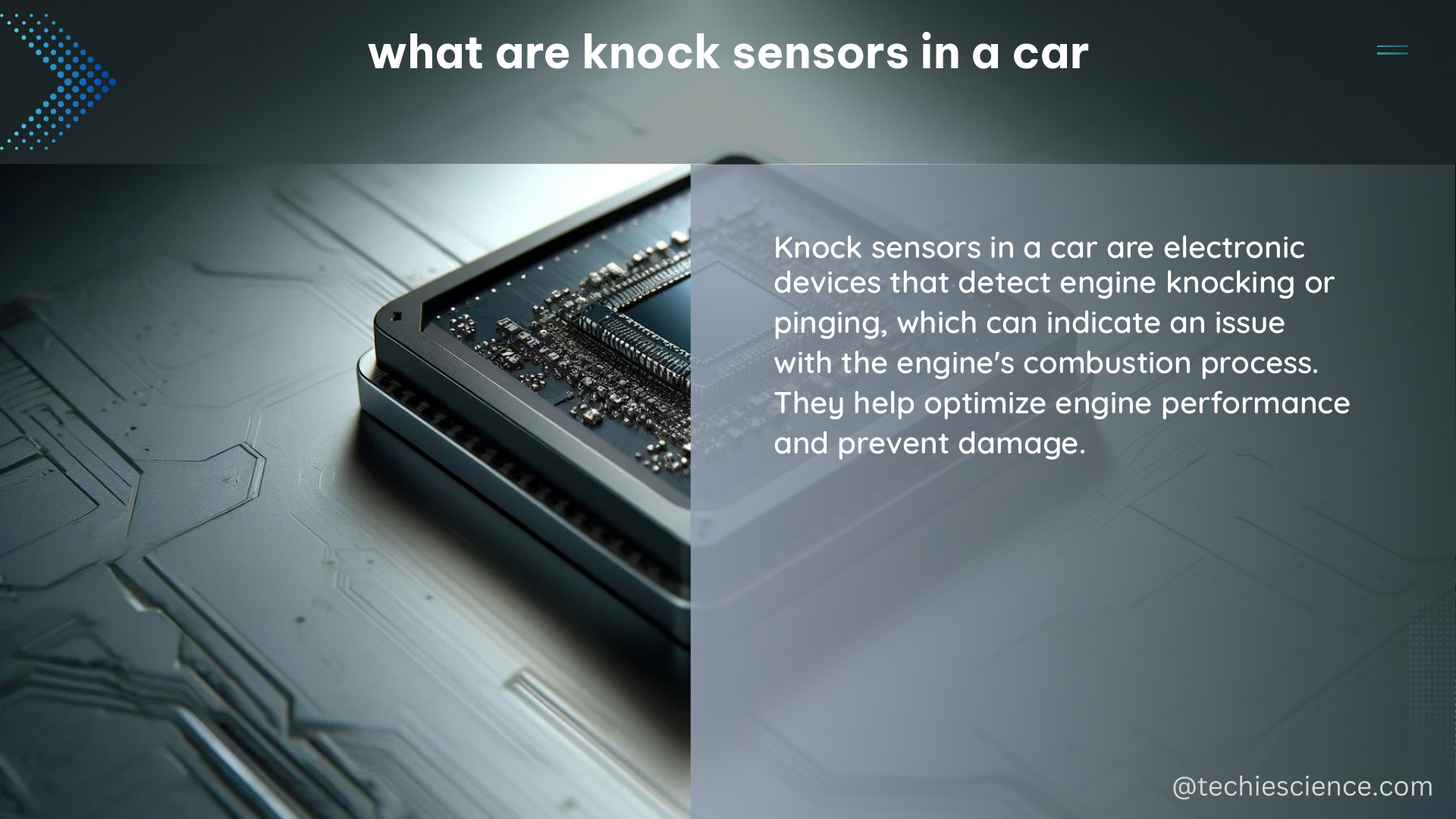A knock sensor, also known as a detonation sensor or a pinging sensor, is a critical component in modern internal combustion engines. It is responsible for detecting engine knock or detonation, which can cause significant damage to the engine if left unchecked. This comprehensive guide will delve into the intricacies of knock sensors, their function, importance, and how to diagnose and replace them.
Understanding Knock Sensors
Knock sensors are typically piezoelectric devices that are mounted on the engine block or cylinder head. They are designed to detect the high-frequency vibrations caused by engine knock, which is a phenomenon where the air-fuel mixture in the cylinder ignites prematurely, resulting in a rapid pressure increase and a characteristic “knocking” sound.
The knock sensor converts these vibrations into an electrical signal, which is then sent to the engine control module (ECM) or engine control unit (ECU). The ECM/ECU then uses this information to adjust the ignition timing, fuel injection, and other engine parameters to prevent further knock and optimize engine performance.
Importance of Knock Sensors

Knock sensors play a crucial role in modern engines for several reasons:
-
Engine Protection: Engine knock can cause severe damage to the engine, including piston and cylinder wall damage, as well as potential engine failure. Knock sensors help prevent this by detecting knock and allowing the ECM/ECU to make the necessary adjustments.
-
Performance Optimization: By detecting knock, knock sensors allow the ECM/ECU to adjust the ignition timing and fuel delivery to the optimal levels, improving engine performance, fuel efficiency, and power output.
-
Emissions Reduction: Knock can lead to increased emissions, as the premature ignition of the air-fuel mixture can result in incomplete combustion. Knock sensors help reduce emissions by allowing the engine to operate at the most efficient and clean-burning conditions.
-
Increased Engine Lifespan: By preventing knock and optimizing engine operation, knock sensors can significantly extend the lifespan of an engine by reducing wear and tear on critical components.
Knock Sensor Operation and Characteristics
Knock sensors are designed to operate reliably even in the harsh environment of an internal combustion engine. Some key characteristics of knock sensors include:
- Temperature Range: Knock sensors can withstand temperatures up to 160°C (320°F) without degradation in performance.
- Durability: Knock sensors are designed to withstand up to 1,000 thermal cycles without failure.
- Sensitivity: Knock sensors are highly sensitive, capable of detecting vibrations in the 5-20 kHz frequency range, which is the typical range for engine knock.
- Signal Processing: The electrical signal from the knock sensor is processed by the ECM/ECU to determine the presence and severity of knock, allowing for appropriate adjustments to be made.
Diagnosing and Replacing Knock Sensors
If a knock sensor is faulty or malfunctioning, it can lead to a variety of issues, including reduced engine performance, decreased fuel efficiency, and the illumination of the check engine light. To diagnose and replace a faulty knock sensor, follow these steps:
- Wiring Inspection: Check the wiring to the control unit by checking for continuity and short circuits to the frame for every wire to the control unit plug.
- Resistance Measurement: Connect an ohmmeter between the knock sensor connector and the removed control unit connector. The resistance should be less than 1 ohm.
- Ground Resistance Check: Check the respective pin at the wiring harness connector against ground using an ohmmeter with the control unit connector removed. The resistance should be at least 30 megohms.
- Oscilloscope Test: Connect the test probes of an oscilloscope between the control unit pin for the knock sensor and ground. The oscillogram should produce a signal with a considerably enlarged amplitude.
- Sensor Tapping: If the signal is not clear, gently tap against the engine block near the sensor. If the knocking is not detected, this indicates a defective sensor or circuit.
- Tightening Torque: Observe the recommended tightening torque during the assembly of the new knock sensor. Do not use spring washers or washers.
By following these steps, you can accurately diagnose and replace a faulty knock sensor, ensuring your engine is running at its optimal performance and efficiency.
Conclusion
Knock sensors are a critical component in modern internal combustion engines, playing a vital role in protecting the engine, optimizing performance, and reducing emissions. Understanding the function, importance, and diagnostic procedures for knock sensors is essential for maintaining a healthy and well-performing engine. This comprehensive guide has provided you with the necessary information to become an expert on knock sensors and their role in the automotive industry.
References
- HELLA (2023). Car knock sensor – function & troubleshooting. Retrieved from https://www.hella.com/techworld/us/Technical/Sensors-and-actuators/Car-knock-sensor-troubleshooting-4012/
- ICDREX (2023). The Ultimate Guide to Understanding Knock Sensors. Retrieved from https://www.icdrex.com/the-ultimate-guide-to-understanding-knock-sensors/
- J.D. Power (2023). What Is A Knock Sensor? Retrieved from https://www.jdpower.com/cars/shopping-guides/what-is-a-knock-sensor
- Bosch Mobility (n.d.). Knock sensor. Retrieved from https://www.bosch-mobility.com/en/solutions/sensors/knock-sensor/
- Cars.com (n.d.). Knock Sensor. Retrieved from https://www.cars.com/auto-repair/glossary/knock-sensor/

The lambdageeks.com Core SME Team is a group of experienced subject matter experts from diverse scientific and technical fields including Physics, Chemistry, Technology,Electronics & Electrical Engineering, Automotive, Mechanical Engineering. Our team collaborates to create high-quality, well-researched articles on a wide range of science and technology topics for the lambdageeks.com website.
All Our Senior SME are having more than 7 Years of experience in the respective fields . They are either Working Industry Professionals or assocaited With different Universities. Refer Our Authors Page to get to know About our Core SMEs.